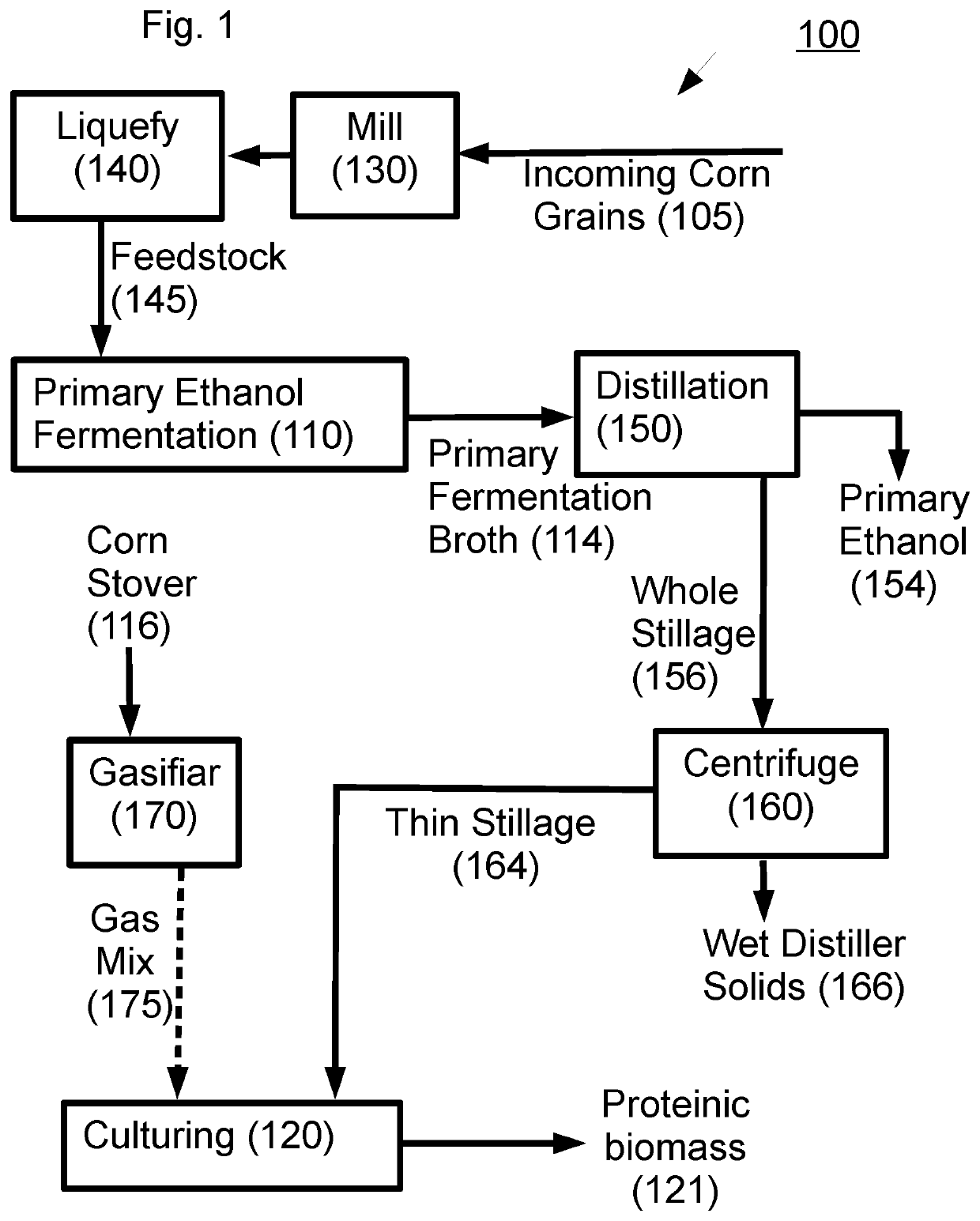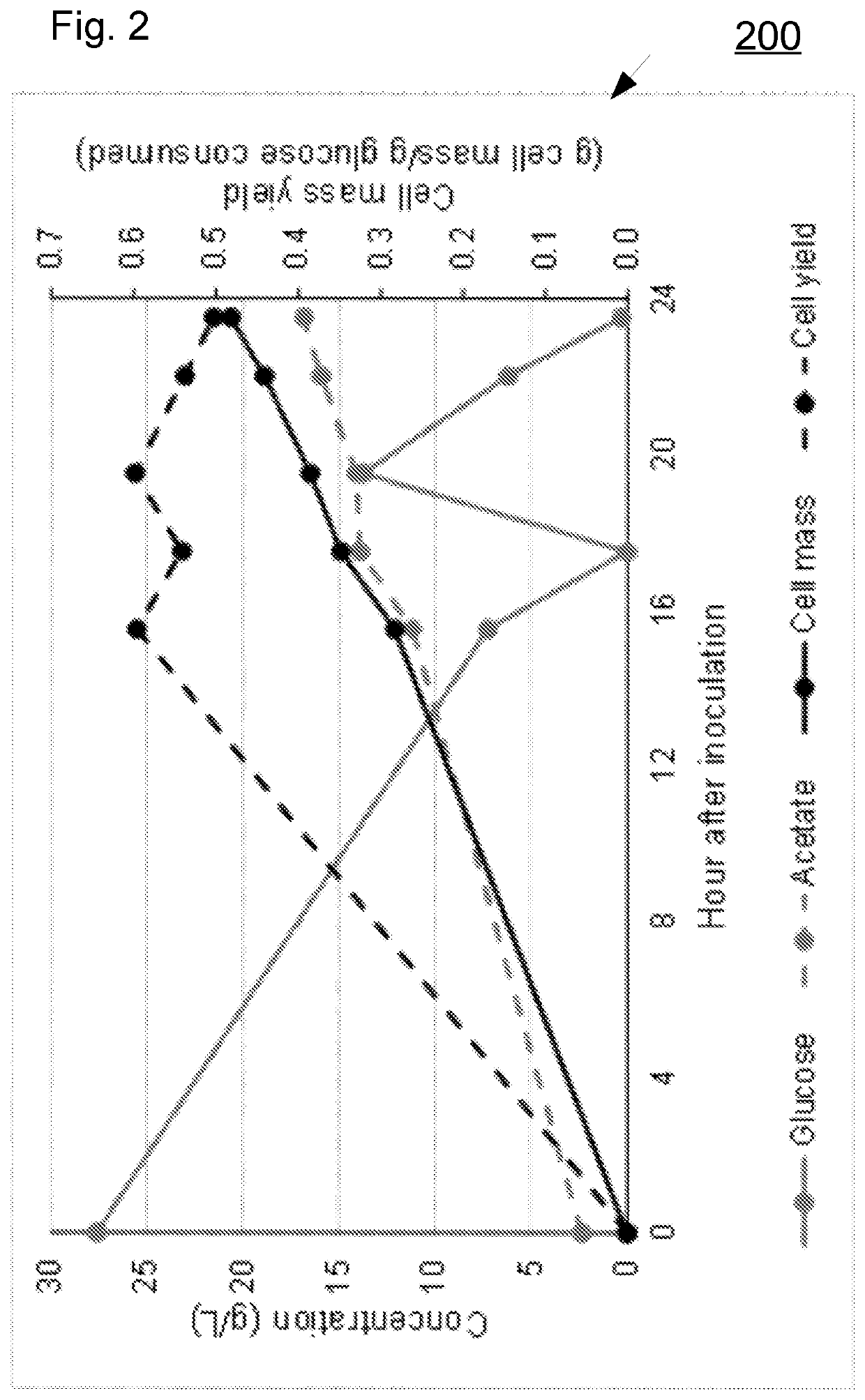Proteinic biomass preparation comprising a non-native organism of the clostridia class
a technology of clostridia and proteinic biomass, which is applied in the direction of lyase, transferase, carbon-carbon lyase, etc., can solve the problems of increasing feed costs, increasing costs, and difficult replacement of fishmeal
- Summary
- Abstract
- Description
- Claims
- Application Information
AI Technical Summary
Benefits of technology
Problems solved by technology
Method used
Image
Examples
example 2
nhibition of Aspartate Kinase
[0109]Butyribacterium methylotrophicum has three annotated aspartate kinase genes: lysC1 (BUME_01940), lysC2 (BUME_01950), and lysC3 (BUME_08600).
BUME_01940 (amino acid sequence)MTTTYMESHSVDGLTVDHKNLMISLKKVPVNSIILTRCLSELSDADVNVDIITQTAPVKNAFDVSFIVLERDLEKVKDIVNALGEEYPEIKITINKDITRLSVSGIGMRTQSGVAAKFFQVLADNDVQILMITTSEIRISCIIKIEDTEKAVAATKEAFDLEDBUME_01950 (amino acid sequence)MSIIVQKYGGTSMGTIDRIKNVARRIIKKREDGNQMVVVVSAMGKSTDELVKMAYSISDAPPRRELDMLLATGEQVSISMLSMALNAMGYDAISFTGPQVGVHTMGHHGKSRIMDIETRKIEDALNDGKIVIIAGFQGVNENDDITTLGRGGSDTSAVALSCVLECPCEIYTDVDGIYGVDPRLYPPAKKLDTVSFDEMLEMASLGAGVMHARAIELGSKYNAEIYVASSIHDVPGTLIKEGDSNMSPMEQQAITGLAIDNDELMVSLKNVPFDMNITAQFFSDLAKKSINIDMISQTAPVYGAINISFSAPIEDLSELRKILYDFMEKYPQVEMDINKEISKLSVVGIGMRSQSGVAAKFFQLLADNNIPMLMITTSEIRISCVIPSELRDTAVMATADAFDLBUME_08600 (amino acid sequence)MEDLIVQKYGGTSVGTVEKIKRVARRIVETKNAGNKVVVVVSAMGKTTDELVDLALAINPNPPSREMDVLLATGEQVSISLLAMAIQTIGHDVVSLTGAQCGIQTSDVHKRARISGIDTARIERELADEKIVIVAGFQGVDENRDITTLGRGGSDTSAV...
example 3
nhibition of Homoserine Dehydrogenase
[0111]Butyribacterium methylotrophicum has one annotated homoserine dehydrogenase gene: hom (BUME_08590).
BUME_08590 (amino acid sequence)MNIGLLGFGTIGTGVYELINLNKGRFAKNLDEKVVITKILDKDPNKKVAEEDKVARVVTNPDDIMDDPEIEIVIALLGGMDFEYGLIKRALQSGKHVVTANKAVISEYFEELLTIAAENNVILRYEASVGGGIPIIGSLKEELKINRVNEIKGILNGTTNFILSKMTEEGADFADTLKLAQSIGFAEADPTADIEGYDVSRKLAILSSLAYGGIIKDEDVRKRGLSDVRAVDIEMAGDYGYIIKYLGHSVLKEGNQVYTTVEPVMFKEASIMSNVNSEFNIISIVGDIIGELQFYGKGAGKDATANAVVGDALYIINCIKDNNFPKPLVFRKQLDKKGVGAFKGKYYLRVDIDSHETFEHALNAVDEVCARKNIIVSDNRVFFMTEPVEADVFDAMVAKIKEKQSECFYARIYE
[0112]This gene is subjected to mutagenesis, such as chemically-induced random mutagenesis or error-prone PCR amplification, and then screened for reduced inhibition by threonine.
example 4
nhibition of Homoserine Kinase
[0113]Butyribacterium methylotrophicum has two annotated homoserine kinase genes: thrB1 (BUME_06990) or thrB2 (BUME_08570).
BUME_06990 (amino acid sequence)MVDGKFIEMQTEIMKNYPPANAQALLNIFNAASGMQEYLDDVLAKTRESYLYTQLRDLVENYYDIGTLLDVYQIFGGYINTSFGIYTEKNGEKQTWFVRKYKNGKELESLLFEHSMLKYARENGFSYGAVPIPAKDGKTYHEVTETTTEGETKSYFAVFNFVGGKAHYDWIPNWANAGVADLTVTSAAKSLAEFHNSTRGFDPEGRHGDNIMDNEDITVNEIIRKFPKTLKEYRKSYAEAGFENVYTEYYDANYDYFAKMCERSVIPDADYNTMVSNVCHCDFHPGNFKYLDNGEVCGSFDYDMAKIDSRLFELGLAIHYCFSSWLSDTNGIINLGRASLFVKTYDEELHKAGGIEPLTAIEKKYLYEVTIQGALYDLGWCSSACVYDSTLDPYEYLFYTQHFVACLKWLEANEEAFRKAFKBUME_08570 (amino acid sequence)MIKVRVPATTANIGPGFDAFGMAFQLYNIFSFEERDNGKLTIRGVERRYQGKSNLVYKAMLKVFNRVHYRPKGIYIYTDVNIPVSRGLGSSAACIVGGLVGANTLCGAPLTGKELFDMAVEMEGHPDNVAPAMFGGLVVSLGLKEENHYIKKEVSQCFEFYGLIPDFTLSTMEARKALPKKVFHKDAVFNVSRATMTYLALTEGRPDILKVSVEDKLHQPYREGLIAHYDEVSQKARELGALNTCISGAGPTLLAITTRDNDQFYAEMGKYLKEKLPGWTLLKLEPDNTGVCTDQHS
[0114]One or more of these genes are subjected to mutagenesis...
PUM
| Property | Measurement | Unit |
|---|---|---|
| Mass | aaaaa | aaaaa |
| Mass | aaaaa | aaaaa |
| Digestibility | aaaaa | aaaaa |
Abstract
Description
Claims
Application Information
 Login to View More
Login to View More - R&D
- Intellectual Property
- Life Sciences
- Materials
- Tech Scout
- Unparalleled Data Quality
- Higher Quality Content
- 60% Fewer Hallucinations
Browse by: Latest US Patents, China's latest patents, Technical Efficacy Thesaurus, Application Domain, Technology Topic, Popular Technical Reports.
© 2025 PatSnap. All rights reserved.Legal|Privacy policy|Modern Slavery Act Transparency Statement|Sitemap|About US| Contact US: help@patsnap.com


